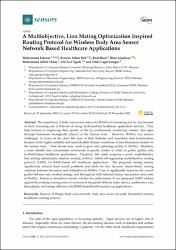| dc.contributor.author | Faheem, Muhammad | |
| dc.contributor.author | Aslam Butt, Rizwan | |
| dc.contributor.author | Raza, B. | |
| dc.contributor.author | Alquhayz, Hani | |
| dc.contributor.author | Abbas, Muhammad Zahid | |
| dc.contributor.author | Ngadi, M. A. | |
| dc.contributor.author | Güngör, Vehbi Çağrı | |
| dc.date.accessioned | 2020-02-17T12:08:39Z | |
| dc.date.available | 2020-02-17T12:08:39Z | |
| dc.date.issued | 2019 | en_US |
| dc.identifier.issn | 14248220 | |
| dc.identifier.other | DOI: 10.3390/s19235072 | |
| dc.identifier.uri | https://hdl.handle.net/20.500.12573/177 | |
| dc.description | Funding text #1 Funding: This research was funded by the Deanship of Scientific Research at Majmaah University, Saudi Arabia. Funding text #2 Acknowledgments: The authors would like to thank the Deanship of Scientific Research at Majmaah University for supporting this work. | en_US |
| dc.description.abstract | The importance of body area sensor networks (BASNs) is increasing day by day because of their increasing use in Internet of things (IoT)-enabled healthcare application services. They help humans in improving their quality of life by continuously monitoring various vital signs through biosensors strategically placed on the human body. However, BASNs face serious challenges, in terms of the short life span of their batteries and unreliable data transmission, because of the highly unstable and unpredictable channel conditions of tiny biosensors located on the human body. These factors may result in poor data gathering quality in BASNs. Therefore, a more reliable data transmission mechanism is greatly needed in order to gather quality data in BASN-based healthcare applications. Therefore, this study proposes a novel, multiobjective, lion mating optimization inspired routing protocol, called self-organizing multiobjective routing protocol (SARP), for BASN-based IoT healthcare applications. The proposed routing scheme significantly reduces local search problems and finds the best dynamic cluster-based routing solutions between the source and destination in BASNs. Thus, it significantly improves the overall packet delivery rate, residual energy, and throughput with reduced latency and packet error rates in BASNs. Extensive simulation results validate the performance of our proposed SARP scheme against the existing routing protocols in terms of the packet delivery ratio, latency, packet error rate, throughput, and energy efficiency for BASN-based health monitoring applications. © 2019 by the authors. Licensee MDPI, Basel, Switzerland. | en_US |
| dc.description.sponsorship | Deanship of Scientific Research, King Faisal University DSR, KFU Deanship of Scientific Research, King Faisal University DSR, KFU | en_US |
| dc.language.iso | eng | en_US |
| dc.publisher | MDPI AG | en_US |
| dc.rights | info:eu-repo/semantics/openAccess | en_US |
| dc.subject | Biomedical sensors | en_US |
| dc.subject | Body area network | en_US |
| dc.subject | Body area sensor network | en_US |
| dc.subject | Healthcare | en_US |
| dc.subject | Internet of things | en_US |
| dc.subject | Routing protocol | en_US |
| dc.title | A multiobjective, lion mating optimization inspired routing protocol for wireless body area sensor network based healthcare applications | en_US |
| dc.type | article | en_US |
| dc.contributor.department | AGÜ, Mühendislik Fakültesi, Bilgisayar Mühendisliği Bölümü | en_US |
| dc.contributor.institutionauthor | | |
| dc.identifier.doi | 10.3390/s19235072 | |
| dc.relation.publicationcategory | Makale - Uluslararası Hakemli Dergi - Kurum Öğretim Elemanı | en_US |


















